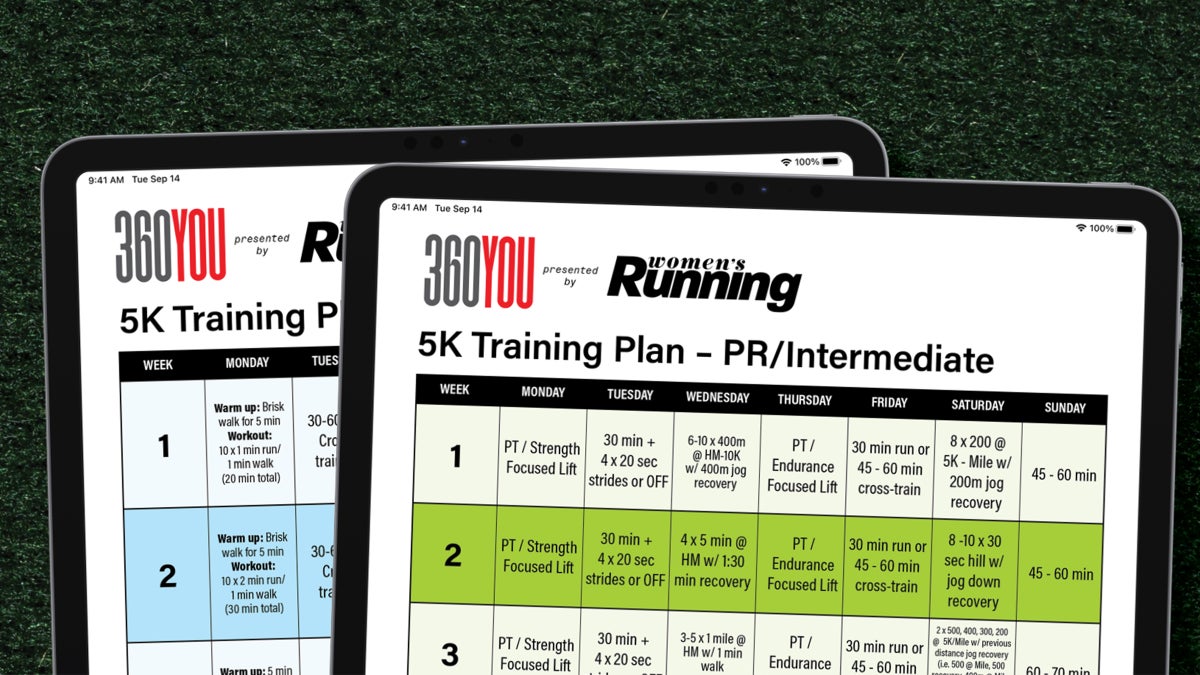Products You May Like
Congratulations 360 YOU runners: You’ve finished the first week of training. Whether this was your first week of running in your life, your first week tackling a formal training schedule, or just another great week in your many years as a runner, you’ve accomplished something impressive, and you should be proud of yourself. Deciding to take on the 360 YOU program and train for a 5K is an investment in yourself as a runner, as a capable athlete, and as the powerful woman you are.
RELATED: Two 5K Plans to Start the Program
Check-in: Beginner 5K Plan
If you’re working through the 5K training plan for beginners, you had a big week with three progressively longer walk/run workouts and two cross-training workouts. This may be your first foray into running or your first time training for a 5K, so there’s a good chance you have some trepidation heading into the program and may have even struggled a bit to make it through your workouts.
You might be wondering why there are so many cross-training workouts on your schedule. Cross-training, which is essentially any non-running exercise, is an important component of training for runners (and especially beginners) because it enables you to build your aerobic fitness base and endurance without your bones, joints, muscles, and connective tissues enduring the high impact of running. Examples of good cross-training activities for runners include hiking, cycling (indoor or outdoor), elliptical, swimming (Mary Cain’s go-to), pool running, rowing, cross-country skiing, and dancing. If you’re really sore and tired from your running workouts, choose an activity that’s particularly gentle on your joints, such as swimming, walking, or yoga.
More cross-training ideas:
The rest days are also an important aspect of your training plan. Though many new runners get so excited about their training that they want to run every day, rest days give your body time to rebuild, repair, and recover. Taking rest days reduces the risk of injury by allowing ample time for your tissues to recover before loading them with the forces of running again, and enables you to hit the next running workout with renewed energy and strength.
As you look at this week’s training schedule, you’ll notice your run/walk workouts are continuing to get more difficult. You’ll work up to 10 x 2:30 running intervals on Saturday, and Wednesday’s workout cuts the walking breaks down to just 30 seconds, which is exciting (and maybe a little scary, too!).
“I know I’ve had programs similar to this when coming back from injury and it can seem so daunting at the start,” says Cain. “Like how can a one minute run feel hard and my goal is a 5K? But if you trust the process, your body always adapts well and safely to the new training load.”
You are building your aerobic endurance, helping you increase the length of time you can run without needing to walk. If you’re finding you’re really struggling to make it through a run interval without stopping early, feel free to slow your pace as much as you want. Your speed isn’t important here; we are just trying to train your body to keep running. A slow jog—even a shuffle—is OK, but try to focus on running with good form without hunching over to ensure you can breathe well.
RELATED: A Day in the Life of Mary Cain
Check-in: Intermediate 5K Plan
If you’re an experienced runner and have stepped up to the intermediate 5K training plan, you also deserve kudos on completing week one. You had a couple of hard workouts, and may have stepped up your pace more than usual. Did it feel good to run fast? Speed work can be intimidating, especially if it’s been a while since you’ve run on a track or really pushed the pace, but these workouts will train your body to handle the faster paces on race day to help you tackle a PR.
You’ll notice that strength training is a significant component of your training program. Strength training makes you a more resilient runner and less prone to injury. It can also make you faster and more efficient, as building strength allows you to be more powerful and can improve your running economy. Your Monday workouts are strength-based, so the focus should be on fewer reps with heavier weights, while the Thursday workouts are endurance-based, so you can lower the resistance and increase the reps and sets. Exercises like step-ups, squats, lunges, rows, push-ups, pull-ups, planks, single-leg deadlifts, glute bridges, clamshells or side steps, v-ups, and other core exercises are great for runners.
RELATED: 6 Prehab Moves to Add into Your Routine
This coming week, your training schedule will have a similar format, but you’ll have more of a tempo-based workout and hills. The tempo workout on Wednesday is designed to improve your lactate threshold, which will enable you to handle faster paces for longer periods of time without fatiguing or experiencing that dreaded heavy legs feeling. Hill sprints are one of the most effective speed workouts because they also make you a stronger runner.
Note that your Tuesday and Friday workouts have choices. If you’re feeling good and are used to running higher mileage, feel free to do the Tuesday run, but if your body needs a break, take a rest day. It’s important to listen to your body and do what feels best. On Friday, you can cross-train or run. If you’re feeling sore, opt for a low-impact cross-training workout.
RELATED: Building Your Village with Team Atalanta
This article is part of our three-month 360 YOU program, available free to Women’s Running members. Find out what the program is all about here or head to the collection page to dive into the available training and inspirational content.
